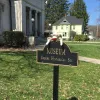Waynesburg
Waynesburg borough residents take pride in their town's 200-year history. In 1796, the five trustees of the newly organized county of Greene purchased a tract of land named “Eden” for their new county seat of Waynesburg. They laid out a grid of streets and alleys, each 180 feet square. Like much of the early architecture, this original grid is intact today. It was incorporated as a borough on January 29, 1816.
Named for Maj. Gen. Anthony Wayne, a Revolutionary War hero, Waynesburg is awash in color, with various techniques applied to historic photos. The color invites us to consider the architectural details with a fresh eye, recognizing features regularly taken for Granted.
There are memory medallions throughout the community. These medallions use a barcode reader with your smartphone to retrieve location information, video, audio, text, and images. Be on the lookout for the bronze Waynesburg Prosperous and Beautiful medallion plaques.




